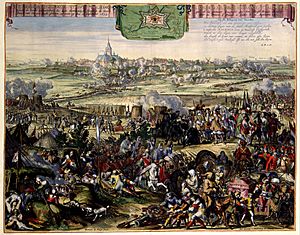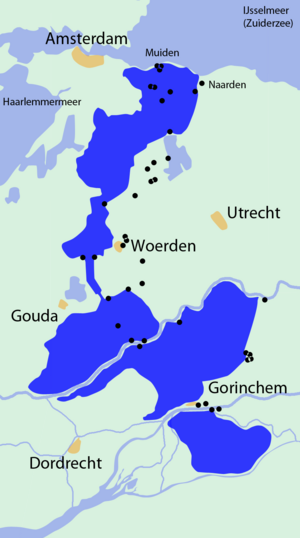Siege of Naarden (1673) facts for kids
Quick facts for kids Siege of Naarden (1673) |
|||||||
|---|---|---|---|---|---|---|---|
| Part of the Franco-Dutch War | |||||||
 Siege of Naarden |
|||||||
|
|||||||
| Belligerents | |||||||
| Commanders and leaders | |||||||
| Strength | |||||||
| 3,000 men | 25,000 men | ||||||
| Casualties and losses | |||||||
| c. 300 | c. 300 | ||||||
The Siege of Naarden was a big battle that happened from September 6 to September 13, 1673. It was part of the Franco-Dutch War. During this siege, a Dutch army took back the important fortress town of Naarden. The French army had been controlling Naarden since 1672.
Contents
How the Battle Started
In May 1672, the Franco-Dutch War began. France, with help from Münster and Cologne, invaded the Dutch Republic. They almost took over the whole country. At the same time, England and France tried to block the Dutch by sea. But this plan failed after the Battle of Solebay.
Naarden is a town close to Amsterdam. The French captured it on June 20, 1672. The French army could not go further into Holland. This was because of the Dutch Water Line. This was a defense system using flooded land. After this, the war became a stalemate.
A Change in Plans
By August 1673, France moved many soldiers away from the Dutch Republic. They needed these soldiers to fight in other areas, like Alsace. This was to protect France's eastern border. This move made other countries, like the German states, want to help the Dutch.
On August 28, the Dutch Republic and the Holy Roman Empire signed a peace treaty. Spain and Lorraine soon joined them. This made the Dutch stronger.
The French also had trouble fighting in Trier. So, many French cavalry (soldiers on horseback) had to move there. This meant the French general in the Netherlands, Luxembourg, had to play defense. He did not like this at all.
Planning the Counter-Attack
William III of Orange, the Dutch leader, felt confident. He started planning a counter-attack. Their goal was to free the lands the French had taken. They chose Naarden as their target.
William ordered Godard van Reede-Ginkel to create a fake attack. This attack was on a town called Grave. It was meant to trick the French. About 1,500 cavalrymen were part of this fake attack.
The main Dutch army crossed the Water Line in the north. They began to surround Naarden on September 6. The trick worked! Luxembourg moved many of his troops towards Grave. This left Naarden less protected.
The Siege of Naarden
The Dutch army, with 25,000 soldiers, gathered around Naarden on September 6. Naarden's defenses were good for that time. In front of the gates, there were special triangular forts called ravelins. These had cannons and were surrounded by a moat (a deep ditch). The Dutch had to capture these ravelins first. Only then could they attack the main wall.
The French commander in Naarden, Philippe de Pracé du Pas, had a problem. He did not have enough gunpowder or bullets. This made it easy for the Dutch soldiers to dig trenches. On the first day, 600 French soldiers went out to cut wood. They needed the wood for defenses. But Dutch troops, led by Godard van Reede-Ginkel, quickly attacked them. The French soldiers scattered. Some were captured.
These captured soldiers told the Dutch about the bad situation inside Naarden. They also said that Du Pas was waiting for help. He expected Luxembourg's army to arrive soon.
The Attack Begins
Luxembourg learned about the attack on Naarden. He traveled back north to Utrecht. He arrived there on September 11. But instead of going straight to help Naarden, he waited for more soldiers. William of Orange did not know this. He wanted to take Naarden as fast as possible.
So, instead of a slow siege, William planned a quick attack. The Dutch cannons had already made big holes in the main wall. The French cannons had almost stopped firing. To succeed, the Dutch had to capture the ravelin in front of the main wall. A Spanish infantry group and a group of Dutch marines would do this. Colonel Palm led them.
The moat around Naarden was too deep. So, soldiers had to make mats from branches. These mats helped them cross the moat. The path was wet, but they could use it for the attack.
The Final Assault
On September 11, at 11 o'clock at night, the trumpets blew. Drums rolled from the Dutch and Spanish camps. Immediately, the alarm bell rang in Naarden. In the dark, the attackers ran across the branch mats. About 600 French soldiers were waiting in the main wall's breach.
Colonel Palm and his soldiers rushed into the breach. The French fired their muskets at them. After a fierce fight, the Dutch and Spanish captured the ravelin. That same night, Dutch cannons were moved onto the captured ravelin. This brought their guns very close to the city walls.
The next morning, no French soldier dared to show up on the walls. The Dutch began to prepare for a final attack. When Du Pas saw this, he asked to talk. William refused his first offer for a truce. Soon after, the city surrendered. The next morning, the Dutch and their Spanish allies entered the city. The 2,700 French survivors were allowed to leave with their weapons and flags. This was called the "honours of war."
What Happened Next
For the Dutch, taking back Naarden was a huge victory. For the French, it was a big problem. The French general Luxembourg told his leaders that the war was not going well. He said he did not have enough soldiers to fight the Dutch.
Naarden showed that the French could not hold their positions in the Netherlands. Their battle line was too long. This meant they had too few soldiers in each spot. An army from the Holy Roman Empire was also coming. This made the situation very dangerous for France.
The French leaders had to make a difficult choice. They thought about leaving the Dutch Republic. King Louis XIV did not want to give up any land. But his advisors convinced him that leaving was necessary.
The allies also captured Bonn, an important French supply base. This showed that the French supply lines were too long. King Louis XIV was very upset. He went to his palace and did not want to see anyone. The next year, only two towns, Grave and Maastricht, were still held by the French.
Commander Du Pas was punished for losing Naarden. He lost his rank and his noble status. He was so ashamed that he sought death in battle. He died the next year during the Siege of Grave (1674).



